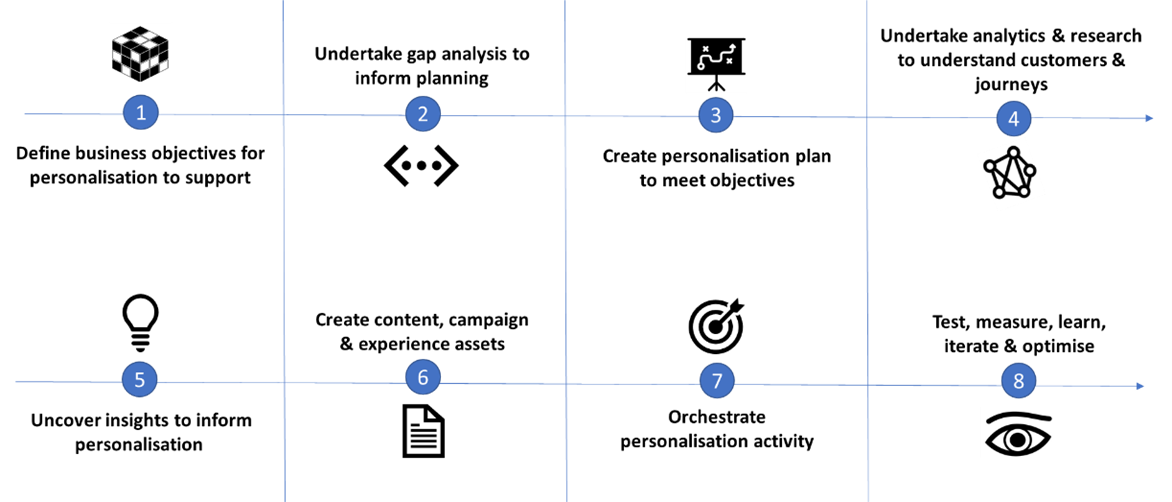
What is hyper-personalisation and why should you care?
Hyper-personalisation has become a growing and often over-used buzz term, but why does it matter and why should you care? Those leveraging data to deliver personal experiences are winning, with hyper-personalisation widely viewed as a key battleground for success. It acknowledges the fact that every person on the planet is different, including how they think, how they behave, what they like and dislike and what compels them to act.
Think about meeting someone multiple times. Firstly, imagine that person remembers your name, your interests and other things you discussed in previous conversations, then compare it to that person forgetting your name every time they meet you and asking the same questions, totally ignorant of your previous interactions. The former approach would leave you feeling content and warm towards the individual, the latter would ensure you avoid that person at all costs.
The same principle applies to consumers and how they view the brands they buy products and services from. Those delivering a compelling, hyper-personalised experience, will gain a disproportionate share of customers compared to those who fail. Advancements in data and technology are now enabling brands to take advantage of this personal touch, delivered through previously impersonal media such as a POS terminal in store. Connection of customer identifiers enables brands to personalise the digital and physical environments.
Customer experience, enabled by data-driven personalisation, is now widely acknowledged as where market share will be won and lost. Cognizant, a leading global consultancy, state that
“by 2020, 89% of companies will be competing on experience, which will overtake price and product as the key differentiator.”
Forbes concur, reporting that
“89% of companies compete primarily on the basis of customer experience – up from just 36% in 2010. But while 80% of companies believe they deliver “super experiences,” only 8% of consumers agree.”
In this blog we will explore the steps required to close this gap.
8 steps to implement hyper-personalisation in your organisation

- Align objectives to solve customer problems
Rather than diving blind into a personalisation initiative, it’s essential to understand the objectives it will support. Most importantly, what customer problems will it help fix, what risks will it mitigate and what will it enable consumers to achieve?
A very simple checklist should include:
- Does it improve customer engagement and/or conversion?
- Does it improve customer experience and ease?
- Does it drive efficiencies and improvements in business operations?
By answering these questions and linking hyper-personalisation initiatives to broader business objectives, buy-in from senior leaders and access to vital budget and people resources will be much simpler. Without it, your initiative will most likely be limited to a localised area of the business supported by few resources, severely impairing your chances of sustained success.
- Gap analysis to inform planning
Successfully implementing hyper-personalisation and making it stick isn’t akin to turning on a tap. Several key areas need to be addressed; company culture, skill set, collateral, processes, data of the necessary quality, format, recency and frequency plus the enabling technology are just some of these.
A comprehensive audit of your capability in these areas will permit a gap analysis to be undertaken to pinpoint the areas that need to be addressed in order to meet your objectives.
- Create personalisation plan to meet objectives
Armed with the gap analysis, you can create a comprehensive plan which supports the achievement of your objectives. All key stakeholders will need to believe in, buy into and sign up to work to the customer goals. Socialising the plan, iterating based on feedback and arriving at a consensus is imperative.
In order to achieve the required buy in, the plan needs to be tightly bound to the customer and business benefits that are anticipated and must have strong, senior leadership backing it for the necessary allocation of resources to fulfil it.
If steps 1-3 sound tough, it’s because they are. However, they don’t need to be a barrier to enhancing the customer value proposition and a compelling plan is the beginning of a customer strategy centred around personalisation.
- Understand consumers, their journeys and motivations
With the key stakeholders bought in and supportive of your plan, anticipation will rapidly build. We now enter the fun, creative phases of personalisation, starting with generating deep insight into consumers.
A combination of analytical, left brained thinking and emotional, right brained thinking are needed at this stage, to understand your consumers’ journeys and their motivations.

- Uncover insights to inform personalisation
There have been huge advancements in both the volume and variety of customer data driven by technology. Data science empowers you to convert this data into customer footprints. How do they behave online, mobile and in your physical locations? What are the apparent points of friction in their journeys and where do they have the greatest engagement and conversion? The key outcome is to identify the points of greatest opportunity to increase engagement.
Research provides the means to understand how consumers feel. What are their emotional triggers? What needs are they looking to satisfy? Customer journey mapping offers the opportunity to visualise how consumers go about interacting with your organisation, from initial research and discovery through to product sale and after care. Qualitative research helps uncover consumer thought processes throughout the journey.
Combining the science of data with the art of research and creativity enables brands to design experiences which are compelling, engaging, useful and satisfying for consumers. Experiences that significantly increase the chances of them becoming loyal customers and advocates of your brand.
- Create content, campaign and experience assets
Armed with compelling insight from data science and research, you are empowered to create relevant content, campaigns and full customer experiences. This is perhaps the most challenging yet rewarding step, where your creativity and brand personality can shine through.
The key to success is to maximise assets whilst minimising cost. Building a smaller bank of modular assets and solutions that can be combined. 10 different assets can become a bank of 100 solutions when each element is personalised to the individual needs.
The assets you create could be online site navigation, informative articles, games, call centre prompts, store associate training, guest experiences or indeed any other form of interaction between the brand and consumer.
In order to create personalisation at scale, an investment in asset creation is required, to have the variety needed to differentiate experience at an individual level and avoid the ‘one size fits all’ model of mediocrity that too many organisations default to.
- Orchestrate personalisation activity
With a bank of content, campaign or customer experience assets at the ready, you are now set for serving these to consumers.
This step requires careful management of every creative asset, ensuring that each individual customer receives a tailored experience which is unified across all touchpoints through which they interact with your brand.
Consistency across channels, enabled by connecting data and using AI to perform real-time analytics, will enable relevant, timely and compelling customer experiences.
- Test, measure, learn, iterate and optimise
Finally, it is vital to recognise hyper-personalisation as a journey, not a destination. Therefore, robust testing and measurement should be implemented from day one. Measuring what matters to your business is crucial here, not getting hung up on vanity metrics.
Rapid testing and measurement provide important learnings, allowing for rapid iteration and optimisation. Modern methodologies, such as Agile, provide the framework for achieving this approach and will ensure that your hard-earned budget is maximised in parallel with consumers receiving the most compelling experiences possible.
Hyper-personalise your customer data strategy
At HyperFinity, we use data science and technology to help businesses decode their customer DNA and deliver hyper-personalisation strategies that drive customer value and business results. Our solutions enable you to deliver relevant experiences to consumers and intelligently personalise every touch point across the customer journey. If you’d like to discuss more, please contact us through the link below.
Visit HyperFinity Get In Touch


